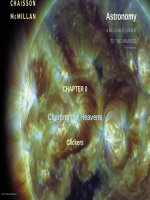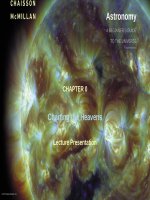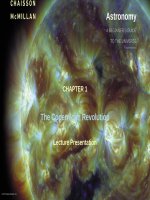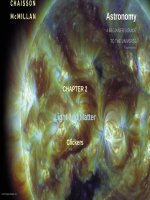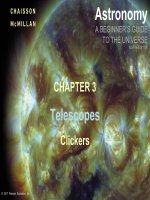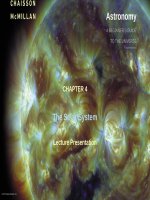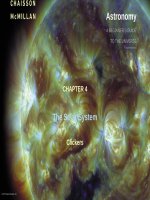Astronomy a beginners guide to the universe 8th CHaisson mcmillan chapter 11 clicker questions
Bạn đang xem bản rút gọn của tài liệu. Xem và tải ngay bản đầy đủ của tài liệu tại đây (2.24 MB, 33 trang )
Astronomy
A BEGINNER’S GUIDE
TO THE UNIVERSE
EIGHTH EDITION
CHAPTER 11
The Interstellar Medium
Clickers
© 2017 Pearson Education, Inc.
Question 1
Some regions of the Milky Way’s disk appear dark because
a)
b)
c)
there are no stars there.
stars in that direction are obscured by interstellar gas.
stars in that direction are obscured by interstellar
dust.
d)
© 2017 Pearson Education, Inc.
numerous black holes capture all the starlight behind them.
Question 1
Some regions of the Milky Way’s disk appear dark because
a)
b)
c)
d)
there are no stars there.
stars in that direction are obscured by interstellar gas.
stars in that direction are obscured by interstellar dust.
numerous black holes capture all the starlight behind them.
Explanation: Dust
grains are about
the same size as
visible light, and they can scatter or block the shorter wavelengths.
© 2017 Pearson Education, Inc.
Question 2
When a star’s visible light passes through interstellar dust, the light we see
a)
b)
c)
d)
e)
© 2017 Pearson Education, Inc.
is dimmed and reddened.
appears to twinkle.
is Doppler shifted.
turns bluish in color.
ionizes the dust and creates emission lines.
Question 2
When a star’s visible light passes through interstellar dust, the light we see
a)
b)
c)
d)
e)
is dimmed and reddened.
appears to twinkle.
is Doppler shifted.
turns bluish in color.
ionizes the dust and
creates emission lines.
Explanation: The same process results in wonderful sunsets, as dust in the air scatters the Sun’s blue light, leaving
dimmer, redder light.
© 2017 Pearson Education, Inc.
Question 3
Astronomers use the term nebula to refer to
a)
b)
c)
d)
e)
© 2017 Pearson Education, Inc.
outer envelopes of dying stars that drift gently into space.
remnants of stars that die by supernova.
clouds of gas and dust in interstellar space.
distant galaxies seen beyond our Milky Way.
All of the above are correct.
Question 3
Astronomers use the term nebula to refer to
a)
b)
c)
d)
e)
outer envelopes of dying stars that drift gently into space.
remnants of stars that die by supernova.
clouds of gas and dust in interstellar space.
distant galaxies seen beyond our Milky Way.
All of the above
are correct.
Explanation: Nebula refers
to any fuzzy patch—bright or
dark—in the sky.
© 2017 Pearson Education, Inc.
Question 4
Interstellar gas is composed primarily of
a)
b)
c)
d)
e)
© 2017 Pearson Education, Inc.
90% hydrogen, 9% helium, and 1% heavier elements.
molecules including water and CO2.
50% hydrogen and 50% helium.
hydrogen, oxygen, and nitrogen.
99% hydrogen and 1% heavier elements.
Question 4
Interstellar gas is composed primarily of
a)
b)
c)
d)
e)
90% hydrogen, 9% helium, and 1% heavier elements.
molecules including water and CO2.
50% hydrogen and 50% helium.
hydrogen, oxygen, and nitrogen.
99% hydrogen and 1% heavier elements.
Explanation: The composition of
interstellar gas mirrors that of the
Sun, stars, and the jovian planets.
© 2017 Pearson Education, Inc.
Question 5
The reddish color of emission nebulae indicates that
a)
b)
c)
d)
e)
© 2017 Pearson Education, Inc.
gas and dust are moving away from Earth.
hydrogen gas is present.
dying stars have recently exploded.
cool red stars are hidden inside.
dust is present.
Question 5
The reddish color of emission nebulae indicates that
a)
b)
c)
d)
e)
gas and dust are moving away from Earth.
hydrogen gas is present.
dying stars have recently exploded.
cool red stars are hidden inside.
dust is present.
Explanation: Glowing hydrogen
gas emits red light around the
Horsehead Nebula.
© 2017 Pearson Education, Inc.
Question 6
Twenty-one-centimeter radiation is important because
a)
its radio waves pass unaffected through clouds of
interstellar dust.
b)
c)
d)
e)
© 2017 Pearson Education, Inc.
it arises from cool helium gas present throughout space.
it can be detected with optical telescopes.
it is produced by protostars.
it reveals the structure of new stars.
Question 6
Twenty-one-centimeter radiation is important because
a)
b)
c)
d)
e)
its radio waves pass unaffected through clouds of interstellar dust.
it arises from cool helium gas present throughout space.
it can be detected with optical telescopes.
it is produced by protostars.
it reveals the structure of
new stars.
Explanation: Cool atomic
hydrogen gas produces 21-cm
radio radiation as its electron
“flips” its direction of spin.
© 2017 Pearson Education, Inc.
Question 7
Complex molecules in space are found
a)
b)
c)
d)
e)
© 2017 Pearson Education, Inc.
in the photospheres of red giant stars.
primarily inside dense dust clouds.
in the coronas of stars like our Sun.
scattered evenly throughout interstellar space.
surrounding energetic young stars.
Question 7
Complex molecules in space are found
a)
b)
c)
d)
e)
in the photospheres of red giant stars.
primarily inside dense dust clouds.
in the coronas of stars like our Sun.
scattered evenly throughout interstellar space.
surrounding energetic young stars.
Explanation: A radio telescope image of the outer portion of the Milky Way reveals molecular cloud complexes.
© 2017 Pearson Education, Inc.
Question 8
Stars are often born within groups known as
a)
b)
c)
d)
e)
© 2017 Pearson Education, Inc.
clans.
spiral waves.
aggregates.
clusters.
swarms.
Question 8
Stars are often born within groups known as
a)
b)
c)
d)
e)
clans.
spiral waves.
aggregates.
clusters.
swarms.
Explanation: The Pleiades—a nearby open cluster—is a group of relatively young stars about 400 light-years from
the Sun.
© 2017 Pearson Education, Inc.
Question 9
Very young stars in small clusters of 10–100 members are known as
a)
b)
c)
d)
e)
© 2017 Pearson Education, Inc.
OB associations.
molecular cloud complexes.
aggregates.
globular clusters.
hives.
Question 9
Very young stars in small clusters of 10–100 members are known as
a)
b)
c)
d)
e)
OB associations.
molecular cloud complexes.
aggregates.
globular clusters.
hives.
Explanation: NGC 3603 is a
newborn cluster of hot young
blue type O and B stars—a
perfect OB association.
© 2017 Pearson Education, Inc.
Question 10
All stars in a stellar cluster have roughly the same
a)
b)
c)
d)
e)
© 2017 Pearson Education, Inc.
temperature.
color.
distance.
mass.
luminosity.
Question 10
All stars in a stellar cluster have roughly the same
a)
b)
c)
d)
e)
temperature.
color.
distance.
mass.
luminosity.
Explanation: Stars in the Pleiades cluster vary in temperature, color, mass, and luminosity, but all lie about 440
light-years away.
© 2017 Pearson Education, Inc.
Question 11
Globular clusters are typically observed
a)
b)
c)
d)
in the plane of our Galaxy.
above or below the plane of our Galaxy.
near our Sun.
in the hearts of other
galaxies.
© 2017 Pearson Education, Inc.
Question 11
Globular clusters are typically observed
a)
b)
c)
d)
in the plane of our Galaxy.
above or below the plane of our Galaxy.
near our Sun.
in the hearts of other
galaxies.
Explanation: Globular clusters
orbit the center of the Milky
Way and are usually seen
above or below the galactic
plane far from our Sun.
© 2017 Pearson Education, Inc.
Question 12
Stars in clusters and associations have about the same
a)
b)
c)
d)
e)
© 2017 Pearson Education, Inc.
age.
temperature.
mass.
color.
luminosity.
Question 12
Stars in clusters and associations have about the same
a)
b)
c)
d)
e)
age.
temperature.
mass.
color.
luminosity.
Explanation: Most of the stars
in a cluster form about the same
time. Stars in the Omega Centauri
globular cluster are estimated to be
about 14 billion years old.
© 2017 Pearson Education, Inc.
